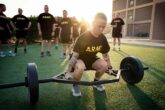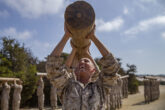November 02, 2020
Justice Ruth Bader Ginsburg and the U.S. Military
As Justice Ruth Bader Ginsburg’s coffin was carried up the steps of the Capitol to lie in state in September, the soldiers who carried the first woman to be so honored were led by another woman of distinction: U.S. Army Capt. Shaye Haver, company commander, 1st Battalion, 3rd Infantry Regiment — the famed “Old Guard” responsible for funerals and other ceremonial duties in the nation’s capital. Haver was one of the first women to complete the Army’s Ranger School, closed to women until 2015. While Army Rangers are sometimes referred to as “door kickers,” in many ways it was Ginsburg who kicked open doors Haver would later walk through.
Today’s military has become more equitable since the start of the all-volunteer force in 1972 when the military draft, which was purely male, was no longer relied upon to fill the ranks. Much of that progress has been due to Ginsburg.
Many Americans are familiar with Ginsburg’s legacy as an attorney, judge, and Supreme Court justice. In addition, a number of the cases she tried and judged emerged from U.S. military policy and had a direct impact on the men and women who serve. The Department of Defense has sometimes used national security and military readiness as excuses to maintain discriminatory practices, such as the limit on women’s service to two percent of military end strength until 1967. Today’s military has become more equitable since the start of the all-volunteer force in 1972 when the military draft, which was purely male, was no longer relied upon to fill the ranks. Much of that progress has been due to Ginsburg.
Read the full article in War on the Rocks.
More from CNAS
-
National Security Human Capital Program
Defending the Army’s Command Assessment ProgramThe concept for CAP — developed during the first Trump administration — benefited from the guidance, input and oversight from the foremost scholar and practitioner on military...
By Katherine L. Kuzminski
-
National Security Human Capital Program
‘Women Don’t Just Achieve…They Excel’: Fmr. Marine Corps Attack PilotDr. Kyleanne Hunter, former Marine Corps attack pilot and CEO of Iraq & Afghanistan Veterans of America, says “women are the fastest growing group of veterans” and “the fastes...
By Dr. Kyleanne Hunter
-
National Security Human Capital Program
Could the U.S. Bring Back the Draft?In this episode of At the Boundary, GNSI’s Dr. Guido Rossi sits down with Katherine Kuzminski, Director of Studies at the Center for a New American Security (CNAS), to explore...
By Katherine L. Kuzminski
-
National Security Human Capital Program
Hegseth Brings the Culture War to CombatThe fundamental challenge of military leadership lies in creating cohesive teams that can work together in an environment of mortal risk and, when called upon to do so, use le...
By Dr. Jason Dempsey




